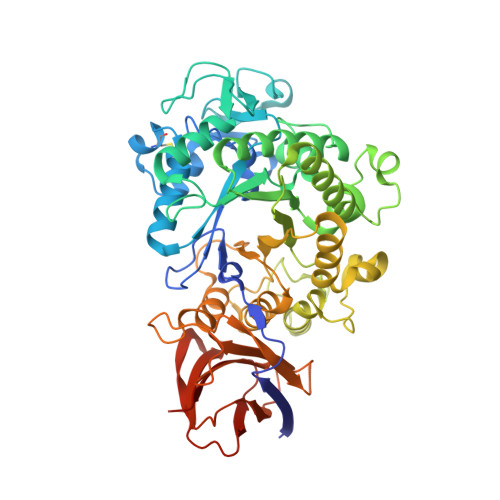Structure and Activity of Paenibacillus Polymyxa Xyloglucanase from Glycoside Hydrolase Family 44.
Ariza, A., Eklof, J.M., Spadiut, O., Offen, W.A., Roberts, S.M., Besenmatter, W., Friis, E.P., Skjot, M., Wilson, K.S., Brumer, H., Davies, G.(2011) J Biological Chem 286: 33890
- PubMed: 21795708
- DOI: https://doi.org/10.1074/jbc.M111.262345
- Primary Citation of Related Structures:
2YIH, 2YJQ, 2YKK, 3ZQ9 - PubMed Abstract:
The enzymatic degradation of plant polysaccharides is emerging as one of the key environmental goals of the early 21st century, impacting on many processes in the textile and detergent industries as well as biomass conversion to biofuels. One of the well known problems with the use of nonstarch (nonfood)-based substrates such as the plant cell wall is that the cellulose fibers are embedded in a network of diverse polysaccharides, including xyloglucan, that renders access difficult. There is therefore increasing interest in the "accessory enzymes," including xyloglucanases, that may aid biomass degradation through removal of "hemicellulose" polysaccharides. Here, we report the biochemical characterization of the endo-¦Â-1,4-(xylo)glucan hydrolase from Paenibacillus polymyxa with polymeric, oligomeric, and defined chromogenic aryl-oligosaccharide substrates. The enzyme displays an unusual specificity on defined xyloglucan oligosaccharides, cleaving the XXXG-XXXG repeat into XXX and GXXXG. Kinetic analysis on defined oligosaccharides and on aryl-glycosides suggests that both the -4 and +1 subsites show discrimination against xylose-appended glucosides. The three-dimensional structures of PpXG44 have been solved both in apo-form and as a series of ligand complexes that map the -3 to -1 and +1 to +5 subsites of the extended ligand binding cleft. Complex structures are consistent with partial intolerance of xylosides in the -4' subsites. The atypical specificity of PpXG44 may thus find use in industrial processes involving xyloglucan degradation, such as biomass conversion, or in the emerging exciting applications of defined xyloglucans in food, pharmaceuticals, and cellulose fiber modification.
Organizational Affiliation:
Structural Biology Laboratory, Department of Chemistry, University of York, Heslington, York YO10 5DD, United Kingdom.





















